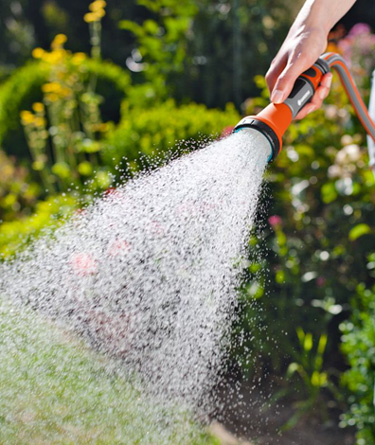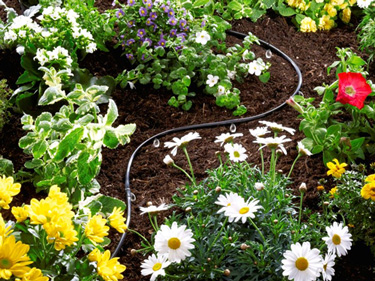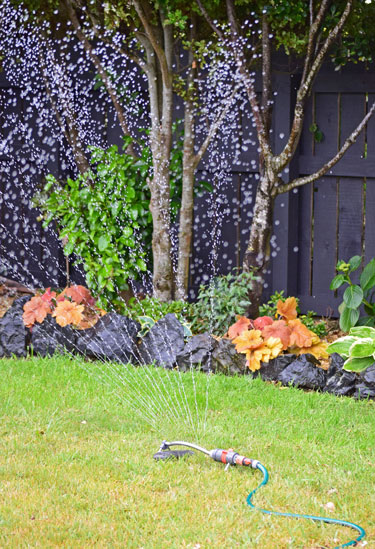Waste not, want not
In times of drought, plants may depend on irrigation for sheer survival. But it’s not just a case of life and death. When moisture is lacking plants fail to look their best, they fall prey to pests and diseases and suffer reduced yields.
In arid regions of the world entire societies have been founded on human-engineered irrigation systems. Here in New Zealand, our water doesn’t always fall in the right place at the right time, but we’re blessed in this land of plenty with more water than most. It’s a national treasure both culturally and economically, valued not only to grow food but for pleasure and recreation.
New Zealand ’s freshwater quality and availability is declining. As gardeners, we have a responsibility to think carefully about our water use. As we move into summer, watering efficiency is front of mind.
When to water
How often a garden needs watering depends on the soil type, the climate and the plants we choose to grow. Generally it’s time to water when the top 2-3 cm of soil is dry. Once the plant starts to wilt some damage will have already been done, although some plants with high water needs (e.g. impatiens) make good indicator plants to alert you that it’s time to water. In times of drought, plants may depend on irrigation for sheer survival.
Plants have different requirements as they age. Seedlings need a little often. Established trees and shrubs with deep roots can cope on their own, even in quite dry climates. As plants mature, the time between waterings can be lengthened. This encourages deep root growth, improving drought tolerance.
Know your soil
The frequency and volume of water you apply should match you soil type. Once you get to know your soil this becomes instinctive. Porous sandy soils need more frequent watering. Regularly applying compost and organic mulch is the best way to improve the water holding ability of your soil over time. Organic matter also improves drainage and permeability in heavy clay soils that can become hard baked in summer.
Watering equipment
One of the ways we can prevent water waste is to invest in durable equipment
that’s a pleasure to use. It may be as simple as replacing an old leaky tap or hose. Non-kink hoses with easy-to-use attachments and handy wind-away hose reels help make watering a pleasure rather than a chore. Even more convenient, a permanently installed irrigation system that’s well-maintained will save time and money. Rain sensor automation and WiFi features are among today’s optional extras. For most of us though, a fabulous watering wand is as high tech as we need to go.
Hand watering
Standing on a summer evening with watering wand in hand while checking plants’ progress is one of the best ways to unwind at the end of the day. This is a good time to water, when baking sun and drying wind won’t evaporate water before it gets to plant roots. Better still, become an early riser; the very best time to water your garden is in the early morning. Hand watering is an excellent way to ensure water goes only where it ’s needed.
Drip irrigation systems
For optimum precision, a drip irrigation system offers a level of water saving efficiency that’s hard to achieve with hand watering and can water your plants for you when you’re not home. Soaker hoses and trickle irrigation lines are especially effective when attached to a timer that’s set to apply the amount of water that ’s needed and no more.
A soaker hose is a perforated tube that allows water to seep slowly into the soil at a rate that the soil can absorb without being lost to runoff and taking precious soil and nutrients with it. Similarly, a drip line with emitters placed next to each plant delivers moisture directly to the soil. Adjust tap pressure so that the water seeps out slowly. Bear in mind that the water pressure will be highest nearest the tap. Rather than one super long hose, run a series of shorter lines no more than 30m long.
Another tick of approval for drop irrigation is that it avoids wetting leaves and flowers, which is an invitation to disease. Lines can be snaked through flower beds or run in straight rows between vege crops.
While useful for lawns and vege beds, sprinklers must be managed carefully to prevent water being wasted on pathways and driveways and other areas not needed. On the upside they’re highly visible, and therefore less likely to be forgotten when it’s time to turn off the tap.
Irrigating pots and hanging baskets
Pots and hanging baskets can demand a lot of watering over summer. Choose larger containers over smaller ones that dry out quicker, and consider glazed or heavy duty plastic pots over porous terracotta for plants with high water needs. Place pots and hanging baskets away from strong wind which can whip the moisture form plants faster than hot baking sun. Grouping pots together is another way to slow moisture loss via evaporation. It also makes life easier at watering time.
Trickle irrigation systems work well for groups of pots or hanging baskets. Hose lines can be concealed along a deck or verandah edge with emitters inconspicuously placed.
Time-honoured traditions
Olla irrigation, often used in permaculture, is popular with gardeners drawn to low-tech enviro-friendly traditions. The terracotta olla pot is sunk into the ground and filled with water. A lid prevents evaporation loss from the top while the water slowly seeps into the soil at a rate that roughly matches plant needs. This system is most useful in dry sandy soils with low water retention and is most common in parts of the world where the pottery is made locally and inexpensively. You can make your own Olla by joining two terracotta pots together with a sealant, blocking the hole at the bottom and covering the open hole at the top with a terracotta saucer.
Swale irrigation is another option which works well for fruit trees planted on gentle slopes. The earth is contoured to trap rainwater, allowing it to soak in to the root zone before escaping down hill.
TIP: Roots will naturally concentrate in the area where the most water is available. Ideally for trees and shrubs, place emitters each side of the plant. For the same reason, it ’s best to provide long, slow watering to allow the water to spread throughout the soil.
10 ways to save water in the garden
| 1 | Cover any bare soil with plants or mulch. |
| 2 | Build moisture retentive soil with regular applications of compost and organic mulch |
| 3 | Hand water so water is only put where it’s needed. Invest in good quality watering equipment that’s a pleasure to use. |
| 4 | Use a wetting agent to maximise water distribution and hold moisture in the soil for longer |
| 5 | Feed with seaweed for strong roots and resistance to drought stress |
| 6 | Water deeply but less frequently to encourage roots to grow deeper into the soil |
| 7 | Recycle grey water wherever possible |
| 8 | Water in the early morning or in the evening to reduce water loss from evaporation |
| 9 | Apply water directly to the soil and root zone (not the foliage) to reduce waste and minimise disease problems |
| 10 | Prioritise drought tolerant shrub and groundcover planting and minimise thirsty lawns |
GREYWATER
Especially in times of drought, allowing the bath water to pour down the plughole is a lost opportunity. Whether its bathwater, shower water, laundry water or the water you washed your veges in, it’s useful for the garden. Collecting household grey water needn’t be complicated. Use a bucket to scoop the water out after a bath or have a wide bucket handy to catch water while showering.
Waste water that isn’t recommended for garden use is toilet water (called ‘black water ’ ) as well as the ‘dark grey’ dirty dishwater from the kitchen sink or dishwasher that is high chemicals and organic matter. Water containing food particles encourages bacteria to grow faster meaning more potential for pathogens, but a lot depends on how big your garden is. While a little spread over a large area may be harmless, fats and grease decompose slowly in soil, so too much can be a problem.
Bacteria and other microorganisms are everywhere, including in the garden soil and on plants. A few of them are germs which cause illness. This is why grey water is not recommended for use on edible plants. It’s good to know, however, that plants don’t get sick from human bugs and that bugs in greywater will not migrate into fruit. It’s important not to store grey water for more than a day. As grey water sits, the bacteria will start to multiply.
There is some concern that washing machine water contains microfibres from synthetic clothes that may be harmful for soil organisms or get into underground waterways, although the extent of this is still unknown. Microfibres degrade very slowly in soil but plants do not absorb them.
For plants, the most harmful chemicals in greywater are sodium (salt), boron and bleach. These occur at various concentrations in soaps, detergents and washing powders, including those labeled ‘biodegradable’.
Another concern is pH, with greywater inclined to be more alkaline. How much this effects plants depends on the pH of the soil as well the pH of the greywater. In rainy weather the risk is less. Yates Greywater Fertiliser helps neutralise the alkaline effect of soaps and detergents and contains a bactericide to kill unwanted microbes.
Greywater wisdom
- Do choose cleaning products that are low in sodium and boron.
- Do use less soaps and detergents whenever possible.
- Do apply greywater directly to the soil, not the above ground parts of the plants.
- Do use greywater on ornamental plants.
- Don ’t apply greywater that may have pathogens in it to vegetable plants.
- Don’t dump greywater in the same spot every time. Share it around your plants.
- Don ’t store greywater for more than 24 hours.

1-Dec-2020

Hand watering

Drip irrigation

Sprinkler watering

